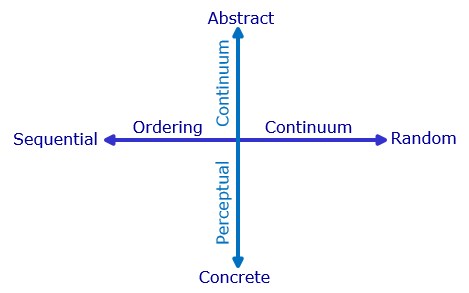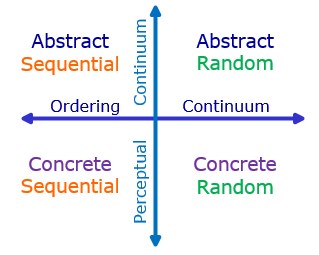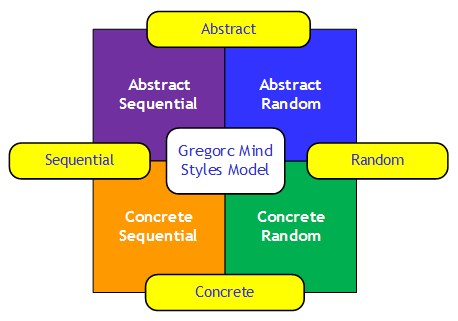Gregorc Mind Styles Model
Anthony Gregorc is the creator of the Mind Styles Model. The Mind Styles Model provides a depiction of how your mind works.
Gregorc’s model helps you gain a better understanding of how you think and learn.
Styles of Processing Information
Gregorc focused his research on measuring how learners perceive and order new information. His model describes four cognitive styles for perceiving, processing, and ordering information.
Gregorc defined a style as a set of displayed behaviors that identifies an individual’s underlying mental strengths and abilities. By knowing your style, you can recognize your strengths and weaknesses when it comes to learning.
Types of Preferences
The Gregorc Mind Styles Model depicts two continuums for how individuals prefer to perceive and order new information.
The two continuums are:
- Perceptual preference
- Ordering preference
Perceptual Preferences
Perceptual preference is how you prefer to grasp or perceive information.
Perceptual qualities are either:
- Concrete, or
- Abstract
Ordering Preferences
Ordering preference is how you prefer to arranges or processes information.
Ordering qualities are either:
- sequential (linear), or
- random (non-linear)
About Each Preference
Perceptual Preferences
Concrete perceptions
When you are using your concrete ability, you are registering information through your five senses. You are dealing with the obvious. You are not looking for hidden meanings, or making connections between ideas or concepts.
Abstract perceptions
This quality allows you to understand ideas, qualities, and concepts that cannot be seen. When you are using your abstract ability, you are using your intuition and your imagination. You are looking beyond what is seen to the hidden meanings and related concepts.
Ordering Preferences
Once you have acquired the information, you then process it mentally. You will have a preference as to how you order that information.
Sequential ordering
This preference involves the organization of information in a in a linear, step-by-step manner. When using your sequential ability, you are following a logical train of thought.
Random ordering
This preference involves the organization of information in chunks and in no specific order. When you are using your random ability, you are able to skip steps in a procedure and still produce the desired result.
Quadrant – Four Styles
The Gregorc Mind Styles Model perceptual and processing modes create four preferred styles. The preferred styles are created by the two intersecting continuums. The intersecting continuums create quadrants. The quadrants are the four combinations of perceptual qualities and ordering abilities based on dominance.
By combining the four types of preferences the following categories of styles are formed:
- Concrete Sequential (CS)
- Concrete Random (CR)
- Abstract Random (AR)
- Abstract Sequential (AS)
Gregorc’s Mind Style Characteristics
Concrete Sequential
- orderly
- logical
- based in reality
- follows directions
- step-by-step processing
- enjoys structure
- organizer
Concrete Random
- experimenter
- takes risks
- using intuition
- divergent thinker
- creative
- skips steps and details
- curious
Abstract Sequential
- structured thinker
- well-organized
- analyzes situations and ideas
- debates ideas
- gathers information
- applies logic
- abstract thinker
- self-directed
Abstract Random
- prefers unstructured environment
- dislikes routine procedures and orderliness
- people-oriented
- creates emotional connections
- creates harmony
- establishes healthy relationships
- uses imagination
- thinks holistic
- imaginative
About Styles
We all exhibit each of the four styles, but we typically have one or two as our preferred or strongest ways to think and learn.
Each person falls somewhere on each of the continuums on the Gregorc Mind Styles Model. We all have the ability to perceive in concrete and abstract ways to some extent. However, we are more comfortable using one more than the other. The same is true with ordering information. We can order information both randomly and sequentially, but we have a preferred style.
Additional Learning Styles
Felder-Silverman Learning Style
Herrmann’s Brain Dominance HBDI
Left-brain and Right-brain Preferences
Myers-Briggs Type Indicator MBTI





